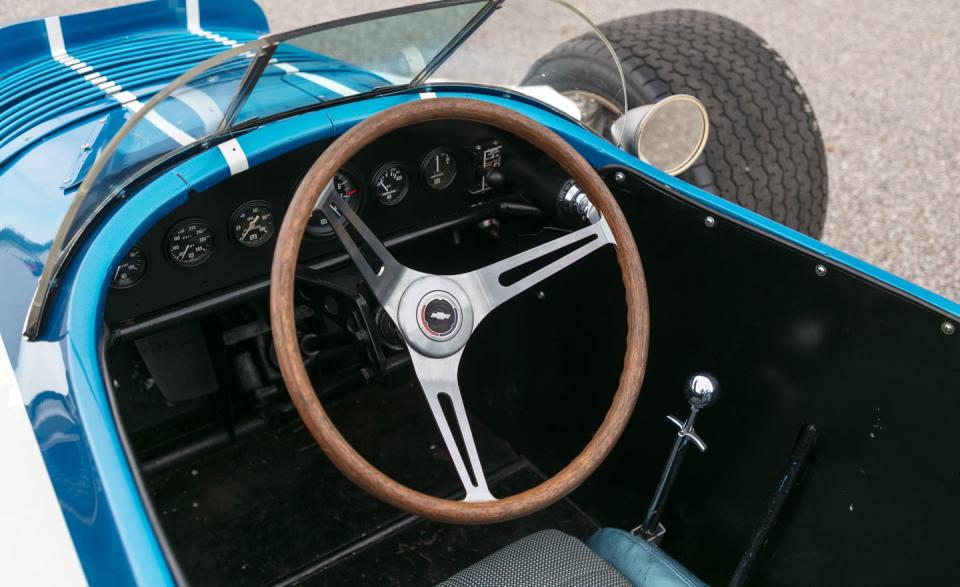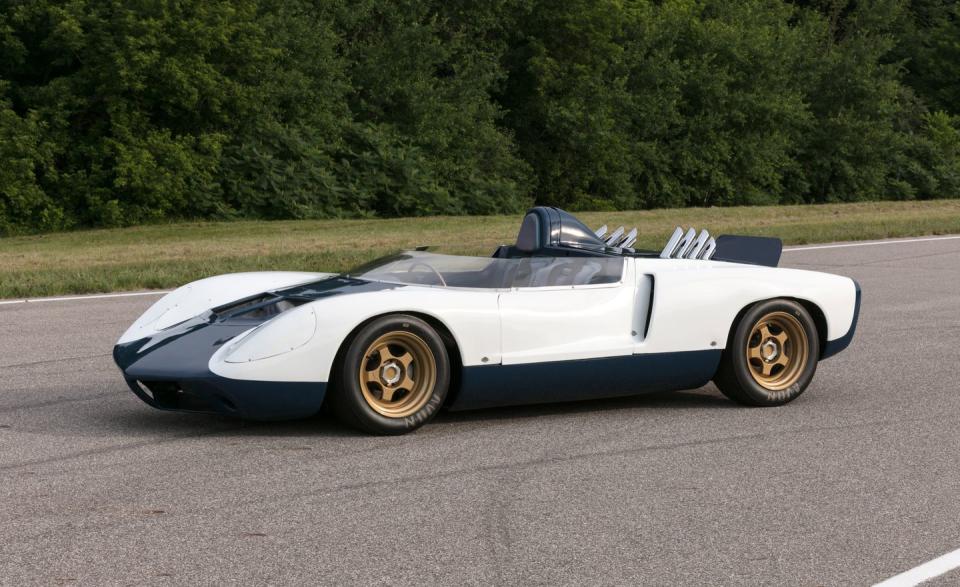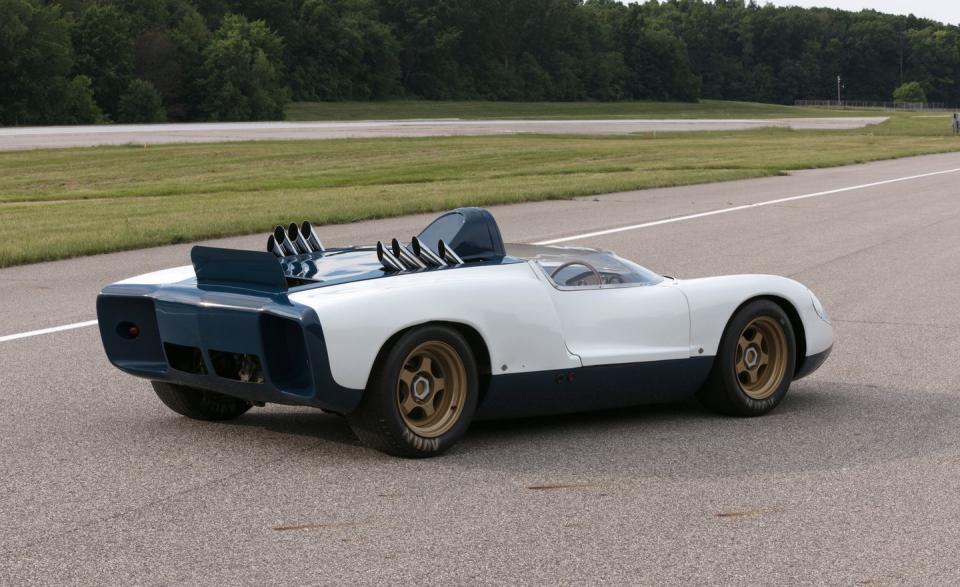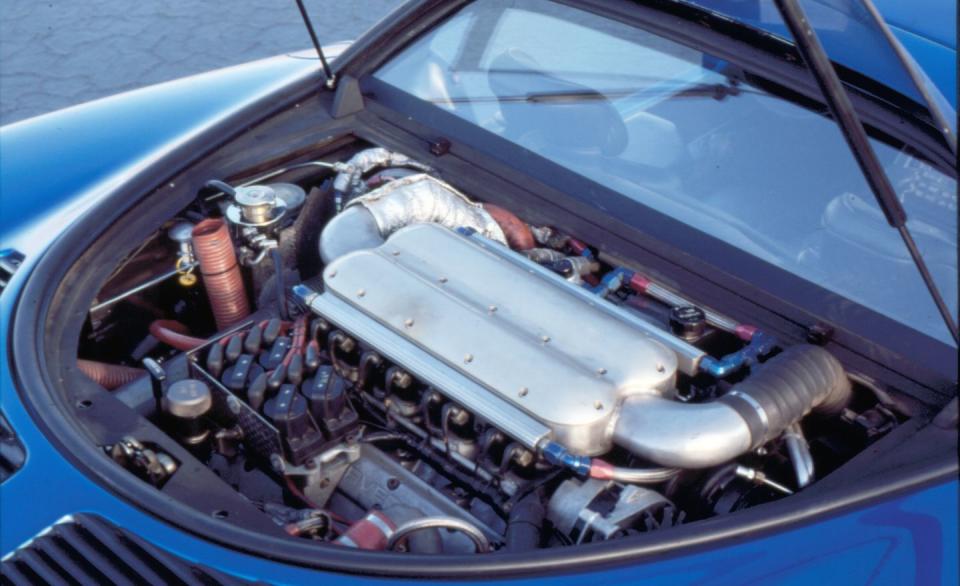Three Mid-Engined Concepts That Foreshadowed the Next Corvette

When General Motors global product development executive VP Mark Reuss was named the event's Enthusiast of the Year, he decided to offer the 2018 Concours d'Elegance of America at Saint Johns an impressive display of an even dozen examples of GM's past, present, and potential future.
From his own collection, he provided a 1962 Corvette Fuelie roadster, a 1963 Corvette split-window coupe, and a new Superformance replica 1963 Corvette Grand Sport racer. From the company's current stable came a 755-hp 2018 Corvette ZR1, a 650-hp 2018 Camaro ZL1 1LE, and (on the other end of the enthusiast scale) an autonomous Chevrolet Bolt EV from GM's Cruise AV program. (Like it or not, that high-tech electric represents a glimpse into our self-driving future.) From GM's Heritage Center came Bill Mitchell's iconic 1959 Stingray racer that previewed the 1963 C2 Corvette's jaw-dropping look, Zora Arkus-Duntov's 1968 Corvette-look mid-engined Astro II Concept, and the first of just 547 sinister black 1987 Buick GNX turbo-V-6 muscle cars built.
The other three-great surprises unannounced before the show-were Arkus-Duntov's CERV I open-wheel Indy-type and CERV II Le Mans prototype concept race cars, plus the swoopy 1990 CERV III concept, from a time when GM Design and others were continuing Arkus-Duntov's passionate push for a production mid-engined Corvette.
Pure coincidence that all three were mid-engined? "Yes, totally coincidental!" Reuss laughed heartily when we spoke with him at the show. "Look at the history of those cars. They were well used as test beds. That period-and those experimental vehicles, in both powertrain and design-was where Corvette was born in terms of competition and research. That's the way I think of them, and you might be surprised how we use the CERV name in the future. I'll just leave it at that." Really? Stay tuned.
1960 CERV I
As Chevrolet director of high-performance vehicles in 1959 (he did not become Corvette chief engineer until 1967), Arkus-Duntov and engineers Harold Krieger and Walt Zetye designed this radical tube-frame, single-seat, open-wheel, independent-rear-suspension, mid-engined concept race car. While mid-engined machines had begun transforming top-rung international Formula 1 racing by the late 1950s-Stirling Moss won the 1958 Argentine Grand Prix in Rob Walker's Cooper, and more success followed in 1959 and 1960-this was a year before the first mid-engined Indy car (a Cooper-Climax driven by Jack Brabham) finished ninth at the 1961 Indy 500, and five years ahead of the first Indy 500 win by Jim Clark's Lotus-Ford, often improperly called a "rear engine" design by Indy 500 fans accustomed to front-engined roadsters.
According to Corvette historian and former Car and Driver editor-in-chief Karl Ludvigsen, in his hugely comprehensive (expanded and updated) book Corvette, America's Star-Spangled Sports Car: The Complete History, Arkus-Duntov started thinking about mid-engine designs for racing cars as early as 1957, partly because of severe cockpit-heat problems in his front-engined Corvette SS racer. And he well understood the traction and handling advantages of locating a rear-wheel-drive racer's engine weight between its cockpit and rear axle.
Designated internally as the R car, it was soon nicknamed the Hillclimber because Arkus-Duntov hoped to use it to establish a new overall record up Pikes Peak, where he had set the record for production cars in 1955. And although it was powered (initially) by an experimental aluminum-block 353-hp 4.6-liter V-8, much larger than was allowed by then current Indy rules, it was optimistically aimed at potential Indy-car competition and designed to those dimensions.
Despite the Automobile Manufacturers Association's 1957 ban on high-performance cars and factory-backed racing, Arkus-Duntov brazenly showed this new creation at the U.S. F1 Grand Prix at Riverside, California, in November 1960. Officially dubbed CERV (Chevrolet Engineering Research Vehicle), it was privately tested and publicly demonstrated there by Dan Gurney and Stirling Moss.
"Detailed photos and carefully worded news releases describing the CERV as 'a research tool for Chevrolet's continuous investigations into automotive ride and handling phenomena under the most realistic conditions' were distributed to the press…," Ludvigsen wrote. "The sight of these men and this fantastically racy open-wheeled car in the midst of the Grand Prix crowd at Riverside was surreal. It was a big, powerful, sleek, blue-and-white question mark."
Although it never saw competition due to the AMA ban, it was used extensively for handling development and demonstrations of the advantages of its mid-engine placement and independent rear suspension. Arkus-Duntov tested the CERV himself at Pikes Peak, Daytona, and Sebring, and in 1964 (with a more powerful 6.2-liter experimental engine featuring Hilborn fuel injection), he reportedly drove it to an astounding average speed record of 206.1 mph on the five-mile circular track at GM's Milford proving ground.
1964 CERV II
Arkus-Duntov and his team upped their concept-race-car ante in 1964 with this mid-engined, four-wheel-drive sports-racer concept. Their initial plan was a closed coupe with an aero-smooth body designed by Larry Shinoda and Anatole Lapine (who would later lead Porsche Design) as the first of a low-volume series of Corvette-branded prototype sports-racing cars, aiming to take on Ford's GT40, Ferrari, and the rest in Le Mans–type endurance racing. Its all-wheel drive was intended to provide an advantage in the foul weather often encountered in long-distance endurance races.
"CERV II-as this car became known-was Chevrolet's planned direct opposition to the Ford GT40," Ludvigsen wrote. "Drafted late in 1963, the initial plan called for the building of a prototype plus six racing cars, three for race entries and three as spares. The aim-an ambitious one-was to make them suitable above all for long-distance events like Sebring and Le Mans while also envisioning entries in the major professional sports-car races in the United States like those at Riverside and Laguna Seca, precursors of the Can-Am series. Entries would be made by independent teams, not Chevrolet."
But just this one open-roadster CERV II was built with all the technologies that Arkus-Duntov and his team believed would make a great race car. Powered by a special 490-hp Hilborn fuel-injected, overhead-cam 6.2-liter aluminum-block V-8, its advanced all-wheel-drive system used two automatic transmissions with torque converters, one in front of and one behind the engine, in a steel and aluminum spaceframe with outboard vented-disc brakes and (eventually) wide, low-profile experimental Firestone tires on Kelsey-Hayes magnesium wheels.
CERV II reportedly reached 200 mph on the banked circular track at GM's Milford proving ground in 1964, and while its racing ambitions were stifled, it proved a very useful R&D and demonstration tool for the proposed production "super" Corvette that Arkus-Duntov passionately wanted to build. Tested at times by the likes of Jim Hall and Roger Penske and powered by 1970 by a 550-hp 7.0-liter ZL1 big-block, it could rocket from rest to 60 mph in a stunning 2.8 seconds. And it previewed the basic configuration (minus all-wheel drive) of Hall's legendary Chaparral Can-Am race cars that Frank Winchell's Chevy R&D group would secretly design and support out of Chevrolet Engineering's back door.
According to Ludvigsen, then Chevrolet general manager Bunkie Knudsen initially approved the CERV II project, then was ordered to drop it by General Motors management due to the AMA ban. But Winchell's group was working on its own GS (Grand Sport) mid-engine racer-also with a Shinoda-designed body-that soon evolved into the aluminum-chassis GS2B that became the prototype Chaparral racer.
"Eventually, the two cars were tested against each other," wrote Jerry Burton in his book Zora Arkus-Duntov, the Legend Behind Corvette. "In March 1964, CERV II was brought down to [Chaparral's headquarters in Midland, Texas] and tested against the GS2, but teething problems with the two-speed box driving the front wheels and problems with the disc brakes caused CERV II to suffer in comparison to the simpler R&D car. As a result, CERV II never saw the kind of limelight on international racetracks that Zora envisioned for the car."
1990 CERV III
A full decade after Arkus-Duntov retired, GM Design was still pursuing mid-engined Corvettes. Because-as we'll see when GM finally unveils its 2020 C8 Corvette-sports-car designers salivate over the low-nose, cab-forward proportions enabled by a mid-engine powertrain. So in 1985, according to James Schefter in his book All Corvettes Are Red, not long after the 1984 C4 Corvette hit the road, GM Design vice president Chuck Jordan had Jack Schwartz's studio create the swoopy mid-engined Corvette Indy concept, which debuted at the 1986 Detroit auto show with a mocked-up 600-hp twin-turbo 2.6-liter Ilmor-Chevy Indy racing engine wedged transversely behind its seats.
Strongly positive media and public reaction led to two more Corvette Indys, a slightly toned-down show car and a running prototype. The former debuted at the 1988 Detroit show with a 380-hp DOHC 32-valve 5.7-liter V-8 (an early version of the engine for the later C4 ZR-1) in place of the Indy race engine. The latter-largely engineered and built by Lotus (which GM owned at the time)-served as an engine and suspension rolling test lab.
Meanwhile, with GM struggling financially under then CEO Roger Smith, the C5 Corvette program slipped from a 1993 model launch to a plan for the 1994, and the engineers were told not to pursue mid-engine proposals. But Jordan kept exploring them anyway. "When GM shut down for its traditional Christmas holiday, five scale-model Corvettes were sitting on display stands in Tom Peters's Advanced 4 studio," Schefter wrote. "Two of them were mid-engined machines."
Those Corvette Indy concepts were followed at the 1990 Detroit auto show by the somewhat more production-feasible CERV III, which previewed the roof shape and some other styling elements of what would eventually become the C5 Corvette. Built by GM Corporate Engineering, with Lotus consultation, it retained a long tail to accommodate its Lotus-tuned 650-hp twin-turbo DOHC 5.7-liter V-8 mounted transversely, which drove all four wheels, thanks to (advanced for then) viscous coupling, through a six-speed automatic transmission. Active suspension and rear steering tightened its turning circle and stabilized high-speed cornering, and its low-drag (0.28 Cd) aluminum-honeycomb-reinforced carbon fiber, Nomex, and Kevlar body sported Lamborghini-inspired "scissors" doors.
"The big deal on that car was an active-suspension hydraulic bladder that we were trying to do on the Corvette at the time," recalls Reuss. "It even had things like yaw control. We spent a lot of money trying to get it done, but it was too unwieldy, too heavy, too expensive, and not quick enough. It was a great test bed, but we could never quite get there on the dynamics."
GM's financial condition continued to worsen through 1991, but Jordan refused to give up. And by early 1992, Schefter wrote, the C5 program (now slipped to 1996) was down to three options: (1) a momentumarchitecture (front engine, rear transaxle, evolutionary body style); (2) a mid-engine architecture, which offered dramatic new styling avenues; and (3) a stiffer and lighter conventional Corvette. And because the momentum option would be the most profitable and highest quality of the three, it finally won out.
The CERV III concept car was tested at GM's Milford, Michigan, and Mesa, Arizona, proving grounds, as well as at Lotus's test track in Hethel, England. But once the decision was made that the next-gen C5 Corvette would be front-engined, the concept disappeared from view. Now it's part of the General Motors Heritage Center's collection.
Interestingly, both CERV I and CERV II were sold some years ago, but both are now back in the Heritage Center collection. "People saw us buy CERV I sort of anonymously at Barrett-Jackson," Reuss related at the show. "But no one knew that we had gotten CERV II back. The gentleman [who owned it] said, 'This probably needs to be home,' so we went and purchased it. This [show] is very special, because no one has ever seen this set of cars together."
('You Might Also Like',)








